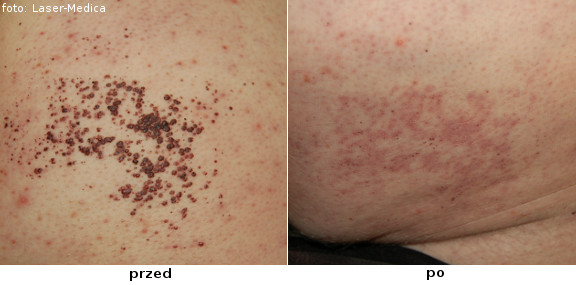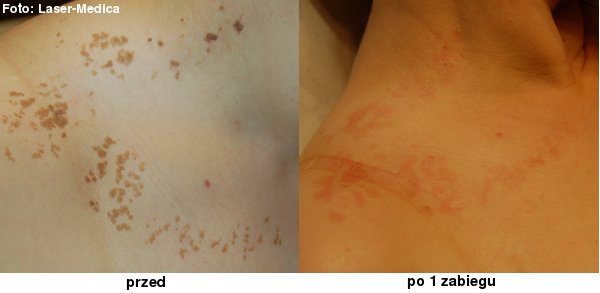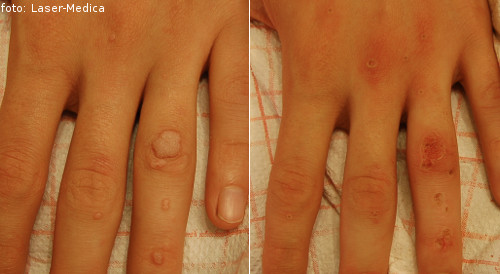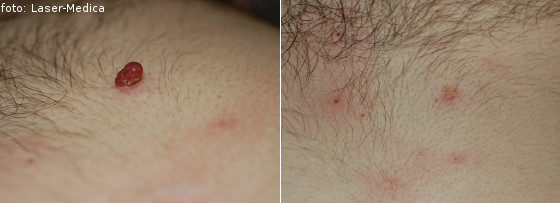CO2 Ultrapuls Laser
 How does it work?
How does it work?
Having the widest spectrum of applications in dermatological practice, CO2 laser has been successfully used in medicine since 1964. The laser emits a beam of light invisible for the eye, with a wavelength of 10 600 nm, which is absorbed by intra- and extracellular water. The laser energy causes vaporisation of water from the hydrated tissue and induces immediate tissue coagulation, in this way inhibiting bleeding during the procedure. The size of coagulation zone depends on the length of duration of a single laser pulse and it is minimal, with the time shorter than 1 millisecond. Modern CO2 lasers have both superpulse and ultrapulse applications and work in the pulse mode, with a duration of a single pulse counted in micro-and nanoseconds. In this way, the technology offers the best control of residual thermal damage and the lowest probability of scarring.
Targeted indications:
- fibromas,
- ruby angiomas,
- viral warts,
- genital warts (venereal warts),
- certain melanocytic naevi (so-called moles),
- tattoos,
- certain types of scars,
- other skin growths;
Contraindications:
- active infection within the treated lesion (bacterial or viral, e.g. herpes),
- tendency to keloids and hypertrophic scars (though CO2 laser is also used for treatment of scars);
There are no contraindications to the treatments in children, pregnant women (if it is necessary to perform the treatment), in cases of tanned skins, as the primary chromophore for carbon dioxide light is water, not skin pigment (melanin and hemoglobin).
The procedure step by step:
1. Anaesthesia - local application (subcutaneous or intracutaneous) of anaesthetic. It's the least comfortable part of the procedure, especially, when the lesions are located in well innervated parts of the body (hands, feet, genital area). In patients with very superficial, few lesions (e.g. flat warts, ruby angiomas), anaesthesia is not necessary - then, during the treatment, patients experience sensation of warmth and little stinging.
2. Vaporisation with laser light beam - depending on the depth and size of the lesion, the treatment may be performed with the use of different laser operating modes (ultra pulsed laser, normal pulsed laser, super pulsed laser).
In contact with the hydrated target tissue, the laser vaporizes skin cells, which leaves the area with no bleeding. The following day, the treated site covers with a superficial, brown scab.
3. The healing process and after-treatment home care - the little wounds may be washed with soap and water and should be disinfected with a preparation containing spirit. In case of larger wounds it is recommended to apply an air-permeable band aid. If it is necessary, superficial scabs on the face and neck may be covered with a make up. The healing process lasts from a few days to 3-4 weeks.
Directly after the wounds have healed up, patients are advised not to tan the skin in the treated area, considering the risk of possible discolouration of new epidermis.
Advantages of CO2 laser therapy:1. A simple, short, painless, usually one-time treatment.
2. No thermal damage to residual tissues.
3. Convenient healing process - no need of withdrawal from social and professional activity, no need to wear a dressing, patients may wash and use daily cosmetics.
4. Satisfactory cosmetic effect.
5. No danger of infection with hepatitis or HIV - the technology enables non-contact treatment.
6. High therapeutic effectiveness.
7. Relatively low cost of the treatment.
Exemplary post-treatment effects - CO2 laser
Angiomas (Angioma serpiginosum)

Epidermal nevus

Warts

Vascular granuloma

*Copying and spreading of the photos without the consent of the owner is prohibited!

